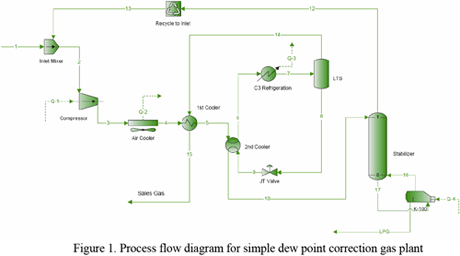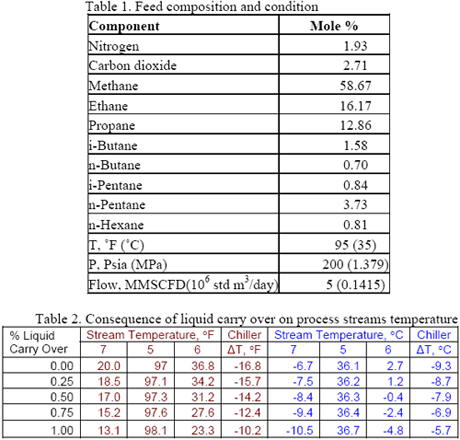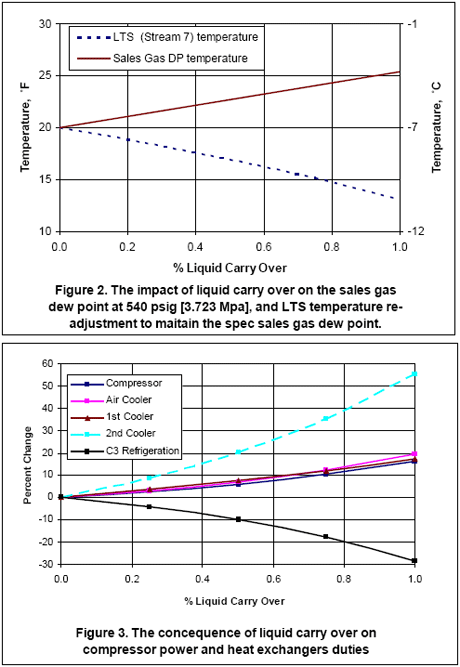Problems in meeting sales-gas dew point specifications are not unusual. A facility engineer often suspects separator carryover when trouble-shooting such a plant. Proper sizing of equipment for vapor-liquid separation is essential to almost all processes. The fundamentals of a simple separator design may be extended to several other processes such as fractionation towers, two-phase flow, slug catcher design etc. Many facility operating problems are related to improperly designed or under-sized gas-liquid separators.
Let’s consider the process flow diagram shown in Figure 1 for a simple gas plant. The feed composition and conditions are shown in Table 1. In one of our past Tip of the Months (TOTM) we demonstrated the impact of liquid carry over on the “sales gas dew point” and we experienced that for even a small liquid carry over (1 %), the dew point offset was about 6°F [3.3 °C]. In this Tip of the Month, we will demonstrate the consequences of liquid carry over on the other equipment while maintaining the “spec dew point”.
It is desired to process this feed gas to produce a sales gas with a dew point of 20 °F (-6.7 °C) at 540 psig (3.723 MPa) The feed gas is mixed with recycle gas from a stabilizer, compressed and cooled to 110°F (43.3°C) and 555 psig (3.827 MPa), then cooled in the gas-gas exchanger, gas-liquid exchanger and finally in the chiller to 20°F (-6.7°C) before entering the separator at 540 psig (3.723 MPa). In real equipment, there would be some liquid carry over. The commercial simulators will assume a perfect gas-liquid separation unless the users manually force some carryover. In order to show the impact of liquid carry over, in simulation we withdraw a small portion of liquid stream from separator and remixed it with the vapor stream. The solid curve in Figure 2 shows how the dew point of sales gas goes off spec as a function of the liquid carry over.
In order to bring back the sales gas dew point to spec, we re-adjusted (lowered) the stream 7 temperature. The required degree of re-adjustment is shown by the dashed line in the same figure. As a consequence of re-adjusting of the stream 7 temperature, the conditions of other equipment and streams changed. Figure 3 shows the variation of compressor power and the heat exchanger duties as a function of liquid carry over. As can be seen in this figure, a-one percent liquid carry over can cause considerable change. For this case, the percent changes ranged from 15 to 55 percent. The changes in the reboiler duty, sales gas and LPG flow rates were negligible. Please note that we assumed variable area of the heat exchangers. If this analysis is done prior to building a new plant, the largest heat exchangers needed could be purchased. However, in an existing plant the heat exchanger areas are fixed. An interesting “surprise” can be seen in Figure 3, the duty of chiller went down as the liquid carryover increased. This is due to the fact that the enthalpy of stream 6 decreases more than the required change in the enthalpy (temperature) of the cold separator. Therefore the process gas duty across the chiller decreases as the liquid carry over increases (see Table 2). In other words, liquid carry-over from the LTS makes the gas/gas heat exchanger into a “chiller” as the liquids vaporizes in that heat exchanger, lowering actual chiller duty, but still increasing the sales gas dewpoint temperature.
Not included in this analysis is an examination of the affect of lowering the chiller outlet temperature on the refrigeration system. In an existing plant, to lower the refrigerant temperature, the chiller would have to operate at a lower pressure so that the power required for the refrigerant compressor would increase. The overall effect of liquid carry over is the increase in the operating cost, as expected.
To learn more about similar cases and how to minimize operational problems such as liquid carry over, we suggest attending our G4 (Gas Conditioning and Processing) and G5 (Gas Conditioning and Processing – Special) courses.
By: Dr. Mahmood Moshfeghian




You made some decent points there. I looked online for the problem and discovered most people will go along with together with your site.
Good afternoon Dr. First of all we hope is well . We are students at the University of East ( Anzoategui – Venezuela ) , to which we referred her article as a subject for a monograph. The overall objective given us is ” Establish control criteria for reducing the impact caused by the fluid drag on the dew point of the gas sale ” . Therefore, we turn to you in order to get more information and help on your part , if possible . We require the following information: description of the process ( more detailed ) data input and output currents in each team rules considered and country where the study was applied , and whether it considers any other pertinent information would appreciate . Thank you very much!